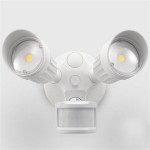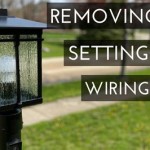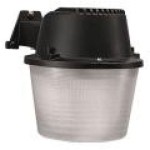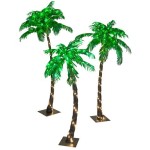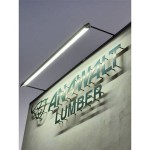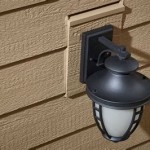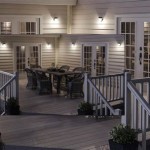Add A Motion Sensor To An Outdoor Light
Motion-activated outdoor lighting provides a valuable security feature for homes, deterring potential intruders while simultaneously enhancing convenience and energy efficiency. By automatically illuminating paths, doorways, and other areas when movement is detected, these systems offer a robust solution for enhancing home security and safety. A motion sensor seamlessly integrates with existing outdoor lighting fixtures, transforming them into intelligent security elements, maximizing their functionality and adding a layer of protection. This article will outline the process of adding a motion sensor to an outdoor light, providing a step-by-step guide for successful installation.
Choosing The Right Sensor
The first step involves selecting an appropriate motion sensor that meets your needs and aligns with the specific outdoor light fixture. Sensor types, power sources, detection range, and mounting options are crucial considerations. There are various motion sensors available, each with unique features and benefits. Some common types include:
- Passive Infrared (PIR) Sensors: These operate by detecting changes in infrared radiation emitted by moving objects. They are typically cost-effective and reliable, offering a wide detection range.
- Microwave Sensors: Employing electromagnetic waves to detect movement, these sensors provide a wider field of view and are less susceptible to interference from weather conditions.
- Dual Technology Sensors: Combining the advantages of both PIR and microwave technologies, these sensors offer enhanced accuracy and reliability, reducing false triggers.
Beyond the sensor type, factors such as power source (battery-powered or hardwired), detection range, mounting options (wall-mounted, ceiling-mounted, or adjustable), and features like dusk-to-dawn operation, multiple zones, and adjustable sensitivity should be considered. The specific requirements of your outdoor lighting situation and desired level of security will guide your choice.
Wiring The Sensor
Once the motion sensor has been chosen, the next step involves connecting it to the outdoor light fixture. This process typically involves connecting the sensor to the existing wiring of the light fixture. The following steps guide the wiring process:
- Turn Off Power: Before starting any electrical work, it is crucial to ensure that the power to the outdoor light fixture is turned off at the circuit breaker. This prevents electrical shock and ensures safety during installation.
- Locate Existing Wires: Identify the existing wires connected to the light fixture. Typically, there will be three wires: a hot wire (black or red), a neutral wire (white), and a ground wire (green or bare copper).
- Connect Sensor Wires: The motion sensor will also have three corresponding wires that need to be connected to the wires from the light fixture. Connect the sensor's hot wire to the fixture's hot wire, the sensor's neutral wire to the fixture's neutral wire, and the sensor's ground wire to the fixture's ground wire.
- Test Connection: After connecting the wires, carefully turn the power back on and test the connection. Ensure that the motion sensor is functioning correctly and that the light turns on when movement is detected.
This process may vary depending on the specific motion sensor and outdoor light fixture, so it is helpful to consult the manufacturer's instructions. It is always advisable to seek professional assistance if unfamiliar with electrical work for safety reasons.
Mounting The Sensor
The final step in adding a motion sensor to an outdoor light involves mounting the sensor in a suitable location. This step is crucial for ensuring proper detection and maximizing the effectiveness of the sensor.
- Consider Placement: Choose a location where the sensor provides optimal coverage of the desired area. This may involve mounting the sensor high on a wall or eave to achieve a wider field of view.
- Avoid Obstacles: Ensure that the sensor's view is unobstructed by trees, bushes, or any other objects that may interfere with its performance.
- Adjust Angle: Many motion sensors can be adjusted to optimize their detection angle. Adjust the angle to ensure coverage of the intended area.
- Secure Mounting: Securely mount the sensor using appropriate screws or brackets to guarantee stability.
After mounting the sensor, test its functionality again to ensure proper detection and adjust its settings as needed. The installation process should be tailored to the specific sensor and outdoor light fixture model, and it is always recommended to consult the manufacturer's instructions for detailed guidance.

Can You Add Motion Sensors To Existing Outdoor Lights Led Lighting Info

Can You Add Motion Sensors To Existing Outdoor Lights Led Lighting Info

How To Add Motion Sensor Outdoor Lights With Or Function Doityourself Com Community Forums

Can You Add Motion Sensors To Existing Outdoor Lights Led Lighting Info

Can You Add Motion Sensors To Existing Outdoor Lights Local Electrical Group

How To Wire Motion Sensor Occupancy Sensors

How To Wire Motion Sensor Occupancy Sensors

How To Add Motion Sensor Outdoor Lights With Or Function Doityourself Com Community Forums

Installing A Remote Motion Detector For Lighting Diy

How To Add A Motion Sensor Your Existing Outdoor Lights In 15 Minutes 24 7 Home Security
